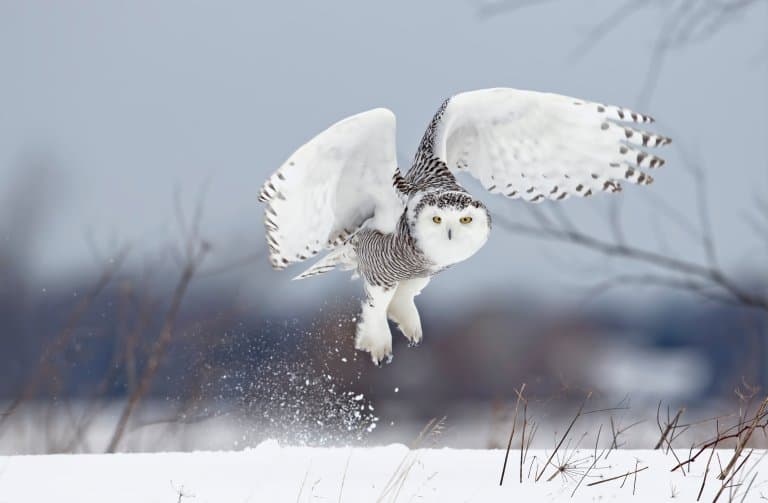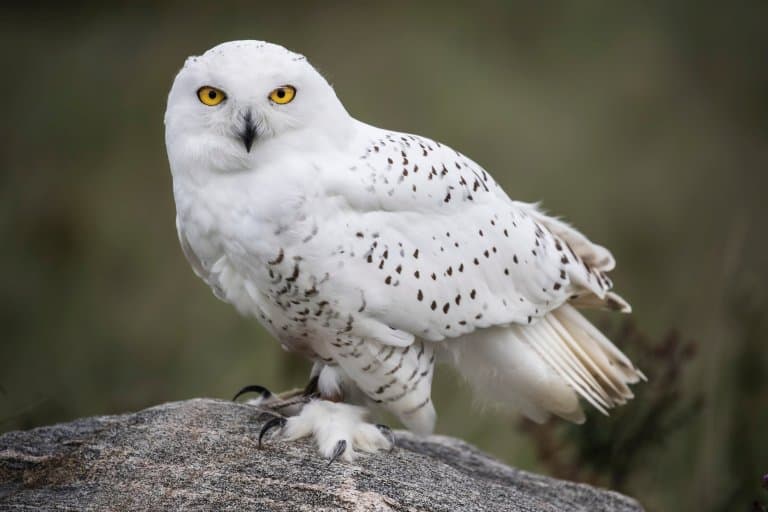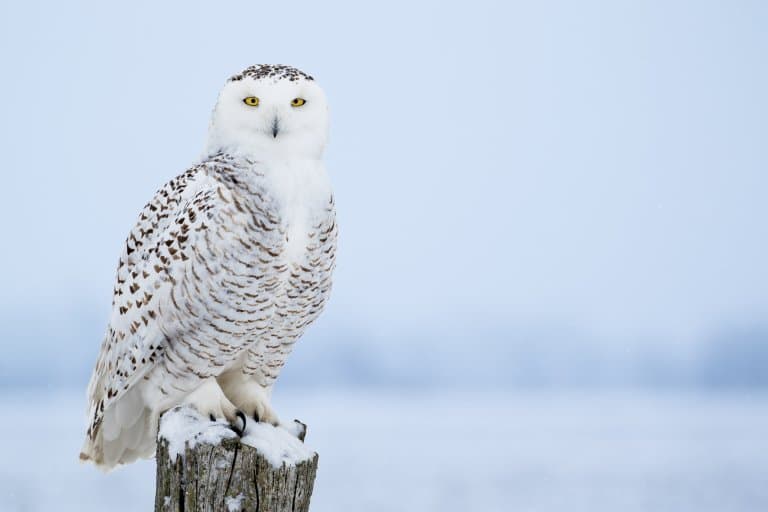Snowy Owl Profile
In the snow-covered plains of the Polar North, there’s a predator so innately specialised, that it doesn’t need sharp wits to dominate its niche. With piercing yellow eyes, contrasted against white feathers, this is one of the most incredible-looking birds
Known to many as Harry Potter’s owl, snowy owls are stunning, elite hunters who have been popular for their looks since long before TV.
The snowy owl is a large white owl of the true owl family that also goes by the names white owl, polar owl, or Arctic owl. It’s native to Arctic regions of North America, Europe and Asia.

Snowy Owl Facts Overview
| Habitat: | Cold weather, tundra, steppe and arctic plains |
| Location: | Circumpolar, Arctic regions, over-wintering as far South as Mongolia |
| Lifespan: | Around 10 years in the wild, up to 35 years in captivity |
| Size: | 69cm (27 inches) tall with a 1.3m (51 inch) wingspan |
| Weight: | Up to 2kg (70oz) |
| Colour: | White with grey or black flecks and yellow eyes |
| Diet: | Mammals, mostly lemmings, some water birds, sometimes carrion |
| Predators: | Arctic foxes and wolves |
| Top Speed: | Up to 80km/h (50mph) |
| No. of Species: | 1 |
| Conservation Status: | Vulnerable (IUCN) |
The word ‘majestic’ gets thrown around in a David Attenborough voice far too often when talking about animals, but the snowy owl genuinely deserves it.
Silent, winged predators with bright golden golden eyes, that give the false impression they’re hiding a deep intelligence.
But when you’re cute, you don’t need to be smart, and this is an owl that takes full advantage of this universal truth.
Instead, it’s expectably well adapted in other ways to the harsh life of 24-hour daylight and unforgiving temperatures of the Arctic.
Interesting Snowy Owl Facts
1. They’re the counter-balance to lemmings
Snowy owls eat a range of small animals during the Winter months, but in the Summer, in their preferred habitat, they are specialist lemming killers.
The vast majority of their food during this time comes from this renowned rodent, known unfairly for throwing itself off cliffs in video games.
In reality, lemmings are another accomplished survivor, and this makes the battle between the two species an epic one.
During ‘lemming years’, when the populations are high, snowy owls breed well. In other years, not so much, but the two are inextricably linked in an ecological tug-of-war, and the success of one directly affects the success of the other.
2. Their eyeballs are long
Snowy owls hunt by sitting still and watching. Their eyes are incredibly powerful, and like other owls, barely recognisable as eyeballs.
Instead of the characteristic sphere shape of balls, owls have elongated tubes for eyes. These were originally designed for acute night vision, but with a little modification, they’re also quite useful for picking out figures against the white snow.
They’re so long, that they can’t be swivelled like your run-of-the-mill eyeball, and this is why owls have had to evolve the ability to turn their heads around as far as they can. 1
3. This makes them a bit thick
Despite their reputation for being wise, the majority of the owl’s cranium is occupied by these enormous eyes. This doesn’t leave a lot of space for the brain, and the result is a beautiful bird that’s as dumb as a bag of spanners.
Instead, owls are a good example of a highly specialised hunter that runs almost entirely on instinct. Intelligence isn’t all that important to a finely-tuned killing machine, and owls run that point into the ground.
Despite being as bright as a wet match, these birds are phenomenally good at what they do.

4. They’re active in the daylight
Unlike most owls, snowy owls hunt during the day. In fact, it doesn’t have a choice, as it lives in a place where there is no darkness.
The Summer days of the Arctic rarely see night, so this owl has adapted its eyesight accordingly, and has to make do with the darkest times of the day, as dusk and dawn provide them with some shrouding for their ambushes.
While this daylight activity led people to believe that the owls were diurnal by nature, newer research is suggesting they’re more active during the night, when they can get it, spending more than 98% of the daylight hours sitting perched on branches.
When they hunt, they generally sit and wait, but are also known to hover in search of rodents. 2

5. Their clutch is determined by their food supply
When resources are plentiful, snowy owls can lay up to 11 eggs, and rear the vast majority of them to independence. But in seasons where their prey is harder to come by, the birds appear to plan ahead, laying fewer eggs, and thus focussing on a smaller number of chicks.
After hatching, it’s a race against time to feed the chicks enough to fatten them up for the approaching Autumn. Without enough food, they will succumb to the plummeting temperatures and end up as food for the chicks that survive. 3
6. They’re covered in feathers
This might not come as a surprise for those who understand that owls are birds, but snowy owls even have feathers where others don’t.
Their beaks and feet are nestled in a tuft of down that helps keep them alive in the formidable cold, amid temperatures that drop to -40°C.
These feathers are the most insulating of any bird known, other than the Adélie penguin. 4

7. They make great figurines
One of the major threats to this species, historically, has been from hunting or collectors.
Such a striking example of a bird has always been popular in the world of taxidermy and back when well-off people would commonly surround themselves with cadavers in their homes, the snowy owl was one of the most prized pieces.
Hunting them for food also plays a role, though this native practice has reduced in recent years. Urban development in the frosty north is slowly encroaching, threatening nesting habitats in some areas. Plane strikes and power line collisions remain a steady threat, as they are for many birds.
As such, the species is listed as vulnerable and in decline by the IUCN. 5
8. Owls make terrible pets
Despite their appeal for being as good-looking as it gets, pet owls are not much fun. Aside from the aforementioned cognitive deficit, they can also be quite noisy at 3 a.m. when they’re at their peak alertness.
Snowy owls, like all birds, are best viewed in sanctuaries, where professional handlers take better care of them, or in the wild, as part of conservation projects like those by the Owl Research Institute, which attempt to figure out the causes of and solutions to their recent decline.

Snowy Owl Fact-File Summary
Scientific Classification
| Kingdom: | Animalia |
| Phylum: | Chordata |
| Class: | Aves |
| Order: | Strigiformes |
| Family: | Strigidae |
| Genus: | Bubo |
| Species: | Bubo Scandiacus |
Fact Sources & References
- Thomas James Lisney (2012), “Eye Shape and Retinal Topography in Owls (Aves: Strigiformes)”, Research Gate.
- “Snowy Owl ~ Bubo scandiacus University of Bristol”, The Owl Pages.
- Best Documentary (2023), “Snowy Owls | Why Is It The Most Skilled Arctic Predator?”, YouTube.
- “UNDERSTANDING OWLS”, The Owls Trust.
- “Snowy Owl”, IUCN Red List.
